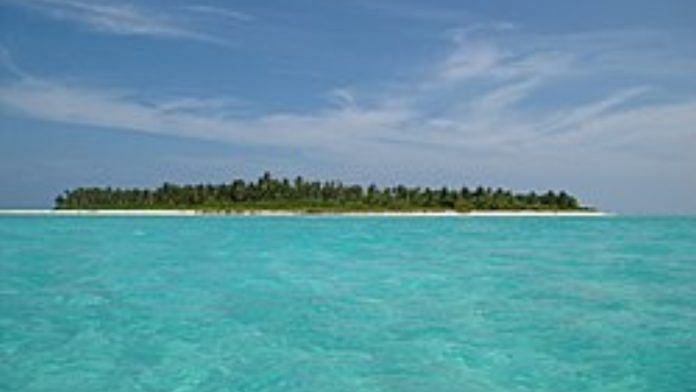New Delhi: While responding to the Opposition’s no-confidence motion in Lok Sabha, Prime Minister Narendra Modi Thursday said that Indira Gandhi gave the island of Katchatheevu to Sri Lanka.
He also said that the Dravida Munnetra Kazhagam (DMK)-led government in Tamil Nadu keeps urging him to reclaim Katchatheevu. A day before Sri Lankan President Ranil Wickremesinghe was to visit India last month, Tamil Nadu Chief Minister M.K. Stalin too wrote to the PM, urging him to initiate diplomatic efforts to retrieve the island.
In his letter, Stalin reportedly wrote that retrieving Katchatheevu will “re-establish historical fishing rights and provide permanent relief to our fishermen”.
By raising this issue, Modi was referring to the India-Sri Lanka maritime boundary agreements signed between the two countries in 1974 and 1976, which demarcated the international boundary between them.
ThePrint explains the history of Katchatheevu and the issues that surround it.
Also read: ‘Not just financial issue’ — why China’s economic slowdown is also a reflection of its politics
An island between India & Sri Lanka
According to a speech by then Sri Lankan foreign minister Rohitha Bogollagama in the Sri Lankan Parliament in 2008, available on the country’s foreign affairs ministry website, Katchatheevu is a barren island located in the Palk Strait about 15 miles (24 kilometres) north-east of Ramanathapuram in Tamil Nadu and approximately 14 miles (22 kilometres) south-west of Delft Islands in Sri Lanka.
There are no inhabitants or permanent structures on the island except for a Roman Catholic church called St. Anthony’s Shrine, which is administered by the diocese of Jaffna, Sri Lanka.
According to media reports, the island was owned by the Raja of Ramnad (present-day Ramanathapuram) and later became a part of the Madras Presidency. From 1921 till 1974, both India and Sri Lanka claimed Katchatheevu for fishing and the island remained disputed till the agreements were signed between both countries.
The two maritime boundary agreements
In June 1974, then Prime Minister Indira Gandhi and her Sri Lankan counterpart Sirimavo Bandaranaike signed an agreement called ‘The Boundary in Historic Waters Between the Two Countries and Related Matters’. Under this agreement, Katchatheevu came under Sri Lankan territory.
Article 4 of the agreement stated that each country shall have “sovereignty and exclusive jurisdiction and control over the waters, the islands, the continental shelf and subsoil thereof, falling on its own aforesaid boundary”.
Article 5 of the agreement allowed for Indian fishermen and pilgrims to visit Katchatheevu without requiring to obtain travel documents from Sri Lanka.
A second agreement was signed in 1976 between the two governments on the ‘Maritime Boundary in the Gulf of Mannar and the Bay of Bengal’.
Article 5 of this agreement made it clear that each shall have “sovereignty over the historic waters and territorial sea, as well as over the islands, falling on its side of the aforementioned boundary”.
Furthermore, Article 5 stated that each country would have sovereign rights and exclusive jurisdiction over resources, whether living or non-living, falling on its side of the boundaries. In short, fishermen from Tamil Nadu no longer had fishing rights around the island.
Arrests of Indian fishermen
In the beginning, historic fishing rights between Indian and Sri Lankan fishermen were maintained around Katchatheevu. The waters surrounding the island are said to have rich resources of prawns, chank shells, pearl oysters and corals as stated by Bogollagama in his speech to the Sri Lankan Parliament in 2008.
Furthermore, as long as the Liberation Tigers of Tamil Eelam (LTTE) operated in northern Sri Lanka, the Lankan government restricted easy movement of their fishermen in the area. After the Sri Lankan Civil War ended in 2009, the country’s navy began patrolling the seas around northern Sri Lanka again.
This led to arrests of Indian fishermen and seizure of their boats and fishing trawlers. According to a response given by Minister of State for External Affairs V. Muraleedharan in Rajya Sabha to a question by MPs Vaiko and M. Shanmugam last month, 74 Indian fishermen have been arrested by Sri Lanka in 2023 alone, along with reports of two attacks by the Sri Lankan Navy. All fishermen have been released, he said.
Between 2020 and 2022, 501 Indian fishermen were imprisoned by Sri Lanka, according to another answer by the minister in Lok Sabha.
Tamil Nadu vs. Union government
In 1991, the Tamil Nadu assembly adopted a resolution demanding the retrieval of the island of Katchatheevu.
In 2008, the then chief minister of Tamil Nadu, J. Jayalalithaa, filed a case against the Union government in the Supreme Court, claiming that the two boundary agreements between India and Sri Lanka are unconstitutional, and to nullify the agreements.
In his 2008 speech, Bogollagama made it clear that any nullification of the agreements by the Supreme Court of India would not be binding on Sri Lanka.
(Edited by Smriti Sinha)
Also read: How Biden has used an executive order to restrict US firms’ investment in China’s high-tech sectors



